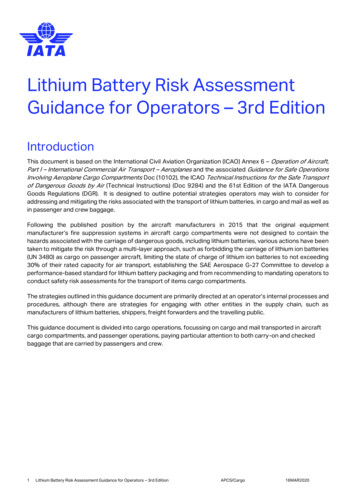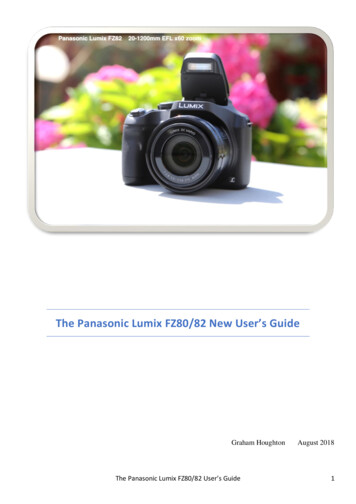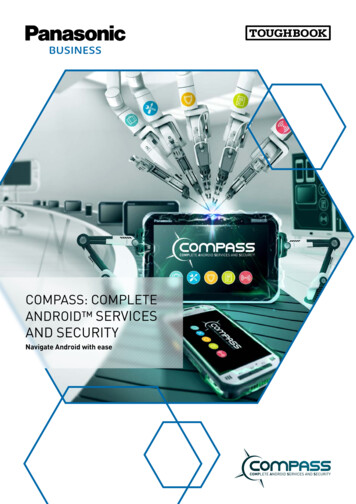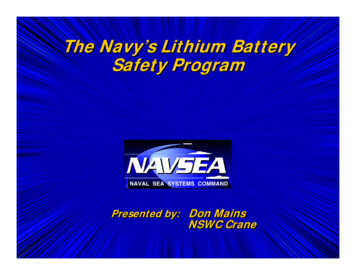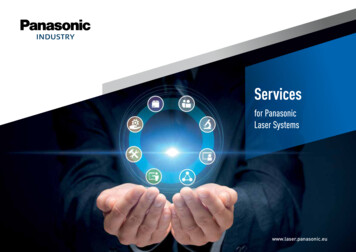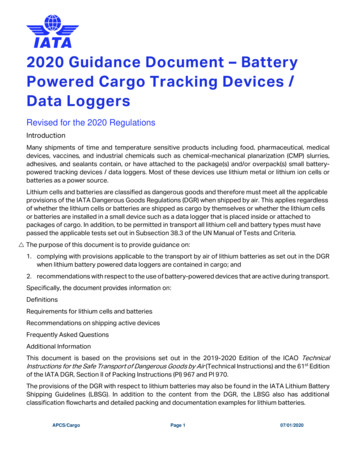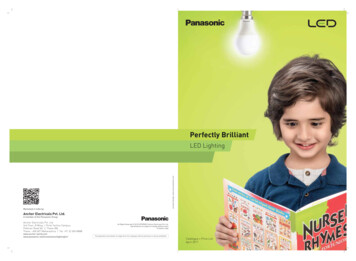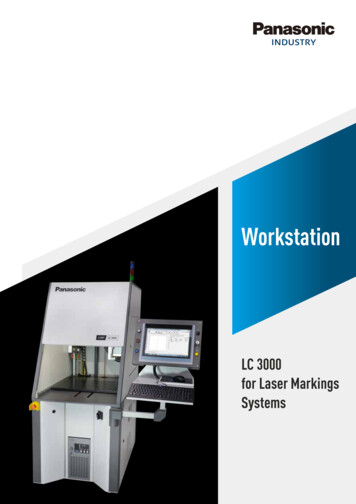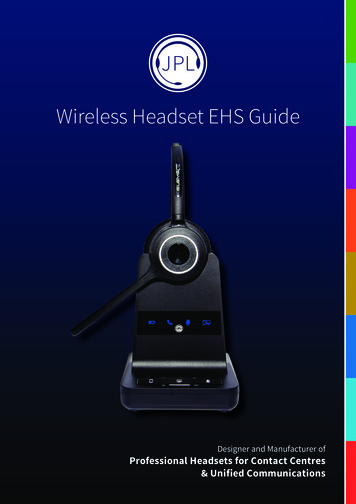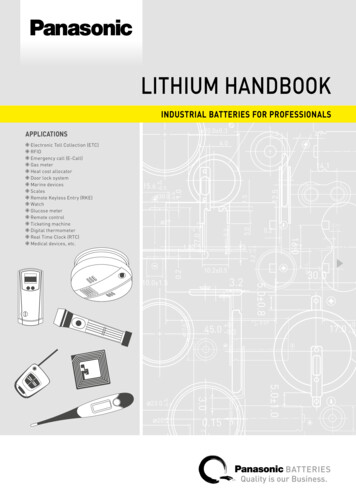
Transcription
0Ø17.0 1.0LITHIUM HANDBOOKInsulatingtubeINDUSTRIAL BATTERIES FORPROFESSIONALSØAPPLICATIONS2.02.94.014.112.51.5 0Ø30.0 0.3 017.0 0.5.0 1.0 03.85.4 0.3Ø27 045.5 1.5Ø17.0 1.02.20.15 0Ø30.0 0.3Ø275.0 0.13.2 0.30.2 027.0 0.7 0Ø17.0 1.0 045.0 0.330.0 03.25.0 0.8Ø20.02.710.2 0.53.0 0Ø23.0 0.5.7545.5 1.50.21.8010.0 1.50.20.2Ø27 0.1 0Ø30.0 0.33.2 0.31.0 015.6 0.516.0Electronic Toll Collection (ETC)RFIDEmergency call (E-Call)Gas meterHeat cost allocatorDoor lock systemMarine devicesScalesRemote Keyless Entry (RKE)WatchGlucose meterRemote controlTicketing machineDigital thermometerReal Time Clock (RTC)Medical devices, etc.20.0 0.3
COMPANYCOMPANYWORLD’S LARGESTBATTERY MANUFACTURERPAISEU UTOMOTIVE & INDUSTRIALSYSTEMS EUROPE GMBHAUTOMOTIVEINDUSTRYCERTIFICATIONS‘Quality is our Business’ – this is what Panasonic stands for. It is the principle for allour batteries and supporting services. This commitment is confirmed by numerouscertifications.PANASONIC ENERGYPanasonic offers a wide range of power solutions for portable and stationary applications. Our product range includes high reliability batteries such as Lithium-Ion,Lithium, Nickel-Metal-Hydride, Nickel-Cadmium, Valve-Regulated-Lead-Acid (VRLA),Alkaline and Zinc-Carbon. With this breadth and depth to the portfolio, we canpower your business in virtually all applications.Our production facilities use leading-edge manufacturing processes that meet thetoughest quality standards. All our factories are certified to ISO standards – withISO 9000 and ISO 14000 being the minimum benchmarks. This means each factoryhas its own quality and environmental management, and delivers products thatmeasure up to toughest standards of reliability.Panasonic began manufacturing batteries in 1931 and is today the most diversifiedglobal battery manufacturer worldwide, with an extensive network of manufacturingcompanies globally. The company employees are dedicated to research, development and production of batteries for an energised world.Most of our factories are also certified to OHSAS 18001 (Occupational Health andSafety Assessment Series), an international standard to assess the managementsystem which organisations have in place for occupational safety. This confirmsthat our factories have been proactive in putting the occupational health and safetyof staff at the centre of the company’s dealings. In addition our VRLA batteries arefor example approved to German VdS standard and the US UL standard.PANASONIC AUTOMOTIVE & INDUSTRIAL SYSTEMS EUROPE GMBH (PAISEU)Our batteries therefore offer benefits – power, safety, long life – which guaranteequality in every respect and deliver the best performance for your application. Findout how we can power your business.Panasonic Corporation, founded in Osaka 1918, is one of the world’s largest manu facturers of quality electronic and electrical equipment. Its subsidiary, PanasonicAutomotive & Industrial Systems Europe GmbH (PAISEU), markets a diverseportfolio of industrial products throughout Europe. Formed in 2014 to strengthenPanasonic’s pan-European industry operations, the company is now active inAutomotive, Industry, Factory Solutions and Energy.In October 2014, Panasonic Automotive & Industrial Systems Europe GmbH(PAISEU), Sanyo Component Europe GmbH (SCE) and Panasonic Industrial DevicesSales Europe GmbH (PIDSEU) merged and now operate as one AIS (Automotive& Industrial Systems) company. In addition, Panasonic Electric Works Europe AG(PEWEU) became a wholly owned subsidiary of PAISEU in October 2014. This neworganisation reinforces Panasonic’s position in the market, creating a strongerbusiness partner for customers, who benefit from the capabilities and technicalsolutions of the combined product and service portfolios.2Panasonic quality – certified byauthorised agencies.3
BATTERY FINDERBATTERY FINDERFIND THE RIGHTBATTERY FOR YOURAPPLICATIONApp versSMARTPHONE APPion 2.1COMPANYWHAT IS?App 2ve.r1sionand o nlineBATTERY FINDERapp & findBATTERIESCONTACTFEATURESHOMEThis is the welcome screen.You can start looking for abattery straight from here,or check out the information on Panasonic anddetails on battery technologies. Good luck!BATTERY FINDERYou can search for thebatteries in three ways: byproduct series, by application or by model number.WHAT IS?If you’re looking for background info, you’ll find ithere in the app’s extensive glossary on batterytechnology. Find out aboutour battery types, productseries and terminal types.BATTERY INFORMATIONYou’re shown the selectedbattery with all the keydetails. You have also several options for requestingdownloads and hardcopies.Designed for engineers, electronics specialists and developers who need batteriesfor their projects, the Battery Finder provides an overview of what’s available in thePanasonic range of industrial batteries, and gives a recommendation on the type ofbattery that’s best suited to the user’s application. It also offers a wealth of infor ma tion, diagrams and videos on battery technology.Search for batteries using three filter criteria:- Search by product series (chemistries)- Search by application- Search by model numberCurrent Panasonic range: now 307 batteriesAutomatic update of rangePictures and technical drawings of all productsProduct datasheetsFavorites selection and sending to interested personFunction for comparing batteries based on technical details (only online application)Function for requesting product material in hardcopy or PDF formatFunction for recommendationFunction for sending an inquiryExtensive information on battery technology (‘What is’ glossary)Videos showing battery structureInformation about the companyPanasonic green battery application videoAll contact details for Panasonic Automotive & Industrial Systems Europe GmbHFunction to save images to smartphone galleryDirect link to Panasonic Battery Channel on YouTubeThere are two versions of the Battery Finder: a smartphone app for iPhone andAndroid devices (2.1) and an online application for computers or tablets.4HTML APPTECHNICAL INFORMATIONIf you’re looking for background info, you’ll find it here – inthe app’s extensive glossary on battery technology. Findout about our battery types, product series and terminaltypes.ersionOnline vBATTERY COMPARISONYou have the option to display two batteries simultaneously. The differences between the products are automatically highlighted.5
YOUTUBE CHANNELMEDIAPOOLDOWNLOAD THE RIGHTBATTERY MEDIA FILESALKALINE (45)LITHIUM (460)LITHIUM-ION (272)NICKEL-CADMIUM(220)NICKEL-METALHYDRIDE (212)VRLA (370)ZINC-CARBON (45)GENERAL PICTURES(90)VIDEOS (14)FIND THE RIGHTBATTERY VIDEOPANASONIC IN MOTIONFEATURESThe Panasonic Mediapool is a complete online library of Panasonic battery images,videos and press releases, providing you with just the right material for all sorts ofprojects. The Mediapool is open to all visitors to the Panasonic website, and offersmaterial for both print and web. The image files differ with respect to their resolution (image size) and color space (CMYK or RGB). For each product, there is also aversion with a shadow (suitable for use on a white background) and without shadow(suitable for use on a colored or grey background). The library contains images inthree formats: JPG, EPS and PNG.Please find a comprehensive selection of Panasonic battery videos at our YouTubeChannel. You can find videos about the inner structure of our different batterychemistries, a video which gives you a clear insight about ‘green’ battery applications and last but not least a video which explains the working of our Battery FinderApp in detail.Find out how we can power your business!New New chemistry Ni-Cd (Nickel-Cadmium) V ideos and press releases now available, in addition to pictures New files appear in the folder ‘New files‘ for three monthsYou can assemble as many files as you need and download them directly to yourcomputer. Here’s an overview of what you can do:Locate the material you need by product name or by clicking through the categories Preview file details – the preview function tells you the full name of the file, its size,format and resolution Select the files you wish to download. You can take files from multiple folders,or select all the material in a particular folder or category in one-click operation –there’s no need to select each one individuallyPreview your personal ‘Download bag’ of the files you have selected The Mediapool zips your data into a file, which you then download to your computer.You unzip the file to the location of your choice simply by double-clicking the filename. The material is then ready for use.6PANASONIC GREEN BATTERYAPPLICATIONPANASONIC NI-MH PRODUCT VIDEO FORPROFESSIONALSPANASONIC ALKALINE PRODUCT VIDEOFOR PROFESSIONALSPANASONIC BATTERY FINDER UPDATE 2.1 –APP & ONLINE VERSION7
INDEXCHAPTER1234568SAFETY WARNINGS AND PRECAUTIONSPAGEPlease be sure to observe the following warnings. As batteries contains flammable substances such as Lithium or other3. Avoid direct soldering to batteries.4. Keep batteries away from direct sunlight, high temperature,COMPANY2–3BATTERY FINDER4–5MEDIAPOOL6YOUTUBE CHANNEL7GENERAL INFORMATION9 – 27SAFETY WARNINGS AND PRECAUTIONS9INTRODUCTION10 – 11D o not charge, short (an exception is to pass batteries1. Do not short-circuit (an exception is to pass batteries throughGENERAL FEATURES12 – 13through dipping solder) disassemble, deform or heat bat-dipping solder), disassemble, deform or heat batteries. DoPRIMARY VS. RECHARGEABLE LITHIUM BATTERIES14teries. Do not throw batteries into fire.not throw batteries into fire.APPLICATIONS15SELECTING A BATTERY/MODEL NUMBER16 – 17BATTERY SELECTION CHART18 – 22GENERAL SAFETY PRECAUTIONS FOR USING, HANDLING AND DESIGNING23 – 26DESIGN FOR MEMORY BACK-UP USE27other series.of batteries with insulating tape, etc. (see fig. 1). When dis-PRIMARY LITHIUM BATTERIES – INDIVIDUAL DATA SHEETS28 – 59A void direct soldering to batteries.posed of improperly, Lithium batteries may short, causingPOLY-CARBONMONOFLUORIDE LITHIUM BATTERIES (BR SERIES) – CYLINDRICAL TYPE29 – 32MANGANESE DIOXIDE LITHIUM BATTERIES (CR SERIES FOR CONSUMER) – CYLINDRICAL TYPE33 – 36of batteries with insulating tape, etc. (see Fig. 1). When dis-MANGANESE DIOXIDE LITHIUM BATTERIES (CR SERIES FOR PROFESSIONALS) – CYLINDRICAL TYPE37 – 38posed of improperly, Lithium batteries may short, causing1. Be sure to connect thePOLY-CARBONMONOFLUORIDE LITHIUM BATTERIES (BR SERIES) – COIN TYPE39 – 43them to become hot, burst or ignite.2. A void mixed use of batteries, i.e. new, used or different types.HIGH TEMPERATURE POLY-CARBONMONOFLUORIDE LITHIUM BATTERIES (BR-A SERIES) – COIN TYPE44 – 47MANGANESE DIOXIDE LITHIUM BATTERIES (CR SERIES) – COIN TYPE48 – 57POLY-CARBONMONOFLUORIDE LITHIUM BATTERIES (BR SERIES) – PIN TYPE58 – 59RECHARGEABLE LITHIUM BATTERIES – INDIVIDUAL DATA SHEETS60 – 76VANADIUM RECHARGEABLE LITHIUM BATTERIES (VL SERIES) – COIN TYPE RECHARGEABLE61 – 66MANGANESE RECHARGEABLE LITHIUM BATTERIES (ML SERIES) – COIN TYPE RECHARGEABLE67 – 72TITANIUM RECHARGEABLE LITHIUM BATTERIES (MT SERIES) – COIN TYPE RECHARGEABLE73 – 76LITHIUM BATTERY TERMINALS AND SOLDERING77 – 79BATTERY TERMINALS781. Do not charge, short (an exception is to pass batteriesSOLDERING LITHIUM BATTERIES78through dipping solder) disassemble, deform or heat bat-TERMINAL TYPES79teries. Do not throw batteries into fire.STANDARDS AND REGULATIONS80 – 81PRODUCT CERTIFICATIONS80FACTORY CERTIFICATIONS80APPLICABLE STANDARDS80LITHIUM BATTERY TRANSPORTATION80SECURITY EXPORT CONTROL80 – 81AVOIDING HAZARDS AND PREVENTING QUALITY PROBLEMS82 – 851. Be sure to connect theAVOIDING HAZARDS822. Avoid mixed use of batteries, i.e. new, used or different types.PREVENTING QUALITY PROBLEMS83 – 85organic solvents, they may cause heating, rupture or ignition.CYLINDRICAL TYPE LITHIUM BATTERIES1and high humidity.COIN TYPE RECHARGEABLELITHIUM BATTERIESWarningWarning1. It may cause rupture or ignite.D o not connect theandelectrodes to each other withmetal or wire. Do not carry or store batteries together witha metallic necklace, etc.2. Do not charge rechargeable batteries with a higher voltagethan specified.3. Keep batteries out of reach of small children. Should a childA void inversed connection ofandterminals to devices. Avoid mixed use of new and old batteries or batteries of2. W hen discarding batteries, insulate theandterminals3. Keep batteries out of reach of small children. Should a childswallow a battery, consult a physician immediately.Cautionswallow a battery, consult a physician immediately.4. W hen discarding batteries, insulate theandterminalsthem to become hot, burst or ignite.Cautionandelectrodes correctly.3. Avoid direct soldering to batteries.4. Keep batteries away from direct sunlight, high temperature, and high humidity.Keep batteries away from direct sunlight, high temperature,Fig. 1 When disposing batteries (example of insulating)*1and high humidity.COIN TYPE LITHIUM BATTERIESInsulation lation ingCR-P2CR-P2CR-P2CR-P22. Keep batteries out of reach of small children. Should a childswallow a battery, consult a physician immediately.3. W hen discarding batteries, insulate theandInsulation inalsof batteries with insulating tape, etc. (see Fig. 1). When sed of improperly, Lithium batteries may short, causingthem to become hot, burst or ulationtapetapetapetape2CR52CR52CR52CR5electrodes correctly.The data in this document are for descriptive purposes only and are not intended to make or imply any guarantee or warranty.*1 Discharge circuits will be made by the contact of batteries, which may cause heating, rupture, or ignition of tapetapetapetape9
1INTRODUCTIONINTRODUCTION1COMPARISON OF LITHIUM PRIMARY CHEMISTRY*1ChemistryBRCathodeMaterialCFMnO2SOCl2Li metalLi metalOrganic electrolyteOrganic electrolyteOrganic electrolyteNominal voltage3V3V3.6VDischarge capacity – ––– –––Voltage during discharge(Initial)Low currentVoltage during discharge(End of capacity)Low currentPulse performance atlow temperatureInitialHigh currentHigh currentEnd of lifeStorage performanceReliabilitySafetyEnvironmentLITHIUM & MICRO BATTERIES:TYPES AND FEATURESERLi metalAnodeElectrolytePerformanceCREco friendly*2*2*3 Very good capability Good capability- Not good capabilityTYPES OF LITHIUM & MICRO BATTERIESEver since Panasonic became the first company in the world to develop and commenceCYLINDRICALTYPEthe mass production of Lithium batteries for consumer products in 1971, Panasonic haslaunched a series of Lithium batteries in many shapes and sizes including cylindrical types,POLY-CARBONMONOFLUORIDE LITHIUM BATTERIES (BR SERIES)MANGANESE DIOXIDE LITHIUM BATTERIES (CR SERIES)coin types and pin types. Panasonic has also successfully introduced coin type rechargeableLithium batteries to the market for applications such as memory back-up or watches.PRIMARY LITHIUMBATTERIES(non-recharge able)Today, Lithium batteries have a proven track record of opening up a host of new fields whereCOIN TYPEPOLY-CARBONMONOFLUORIDE LITHIUM BATTERIES (BR SERIES)MANGANESE DIOXIDE LITHIUM BATTERIES (CR SERIES)conventional batteries cannot be used. Applications range from high-current dis chargeapplications typified by 35 mm cameras to ultra-low current discharge appli cations in suchPIN TYPEproducts as electronic watches or applications as power supplies for IC memory back-upwhich require long-term reliability.LITHIUM &MICRO BATTERIESPOLY-CARBONMONOFLUORIDE LITHIUM BATTERIES (BR SERIES)Panasonic has conducted repeated tests on the various safety and performance characteristics, plus the effects of environmental factors such as temperature. We have accumulated aVANADIUM RECHARGEABLE LITHIUM BATTERIES (VL SERIES)wealth of corroborative data on the performance of our batteries which cannot be pinpointedby short-term accelerated tests. As a result, Panasonic batteries have won approval underthe UL safety standards in the United States and wide recognition throughout the world forRECHARGEABLELITHIUMBATTERIESCOIN TYPEMANGANESE RECHARGEABLE LITHIUM BATTERIES (ML SERIES)their high reliability and safety.TITANIUM RECHARGEABLE LITHIUM BATTERIES (MT SERIES)10The data in this document are for descriptive purposes only and are not intended to make or imply any guarantee or warranty.*1 Please contact Panasonic to get more detailed information about this technical comparison overview.* 2 Impedance is increasing due to the passivation phenomena.* 3 Harmful substances included.11
Voltag3V1.5V1hthe data of C-MOS IC1.2VGENERAL FEATURES1.5V1.2VLithium3V Silver1.55VManganeseNi-MH1hGENERAL-10 CFEATURES1cycle1h 1hto achieve increasing miniaturization. A single Lithium batterycan replace two, three or more conventional batteries. The figure on the right shows the number of cells required to provideOperating voltage (V)BR-C (cylindrical type)9080BR-C (cylindrical type)903.001.5Storage temp.: room temp.Storage period (years)0502025301.5V1.2V3.02.5Silver Manganese Ni-MHVoltage maintainingthe data of C-MOS IC1.0Low selfdischargerate and superior storability3V1.55V1.5V1.2VSince the substance that is chemically very stable is used for0SilverManganese (BRNi-MHseries: Poly-Carbon plus terminal as Lithiuman activematerial0-10 uration2,5002,5007710Voltage (V)Voltage (V)Storage period (years)BR-C (cylindrical type)BR-2325 (coin type)908052003.02.520 CBR-2330A2.0-10 C1.5Self discharge performance at 100 C1.0CapacityVoltage(V)retention (%)3.51,0005001003.012.5245 C1,500435Duration20 C902,0002,500Load:763,000 (days)2.2MΩ(1.3µA)(years)-10 C2.0801.52233700.500550020 C1101520 Storage(months)30kΩ ( 97µA)1,0001,500Load:2,0002,5002Long-term discharge0 C345673,000Long-term discharge has been verified at all operating tem1.5peratures under low-load discharge on3,000(hours)2,0004,0005,000556 67 (years)7 (years)Lithium batteries employ organic electrolytes with minimumBR-2325creep ing so they are vastly superior in terms of µAcurrent1mADischarge10mA 100mABattery voltageBattery voltageBattery voltage106810300 40Battery temperature468CurrentBattery temperature0Current1230Current1202402167(hours)3 Duration45673 Duration4 (hours)567260 C1 month45 C/90%3 monthsLeakage resistance evaluation itemsTest conditionsHigh temperature storage60 CThe batteries achieve stable characteristics under high tem-High temperature45 C/90% RHperature and humidity conditions (45 C/90% RH, 60 C/90%High humidity storage60 C/90% RH1 month1h1h20060 C/90%2003 months200 0203001000100 020001 month200150Temp. cycleHeat shock60 cycles120 cycles3 monthsBR-2/3A150BR-2/3A150100BR-2/3A100100 characteristicsVL Charge5060 C60 CTemperature cycle45300 204020030100Duration (hours)ConditionsStorage300 3040200Battery temperature2460types of batteries that employ aqueous solution electrolytes.1h1h 1h1h1cycle1cycle1h1h-10 C-10 CWide operating temperature rangeused in other types of batteries, Lithium batteries are capable10µALeakage resistance test resultsOutstanding electrolyte leakage resistancethat is much lower than the aqueous solution electrolytesVoltage at 50%discharge stateVoltage at 50%discharge stateVoltage at 50%discharge state0 C20 C-20 C0 C20 C-40 C-20 C0 C1mA 10mA 100mA-40 C-20 Ccurrent1mADischarge10mA 100mA-40 C0Modelnumber Load: 30kΩ (days)( 97µA)45 C20 C0 CThe data in this documentareonly 6and are 7notintended to make or imply any guarantee or warranty.12 for descriptive34 1082,5002,500(days)(days)Due to the use of organic electrolytes with a solidifying point2.02.52,0002,000est challenge for batteries.Duration2.501,5001,5004460 C1210RH), and even under heat shock which constitutes the sever-1.03.01,0001,00060 C45 C121000resistance under environmental changes compared to other1100045 C1.0BR-2/3A0DurationDurationLoad: 2.2MΩ (1.3µA)45 C01501.51.550050045 C20 CBR-2325 Charge resistance (10V consistent-voltage charge)2.02.01110Storage period (years)0 Load:30kΩ30kΩ( 97µA) ( 97µA)Load:2.52.51.01.000Storage temp.: room temp.3.501.6Time eBatterytemperature( C) ( C) ( C)Capacity retentions (%)51000 C0 C3.03.0Storage temp.: room temp.020 C20 C20 C0 CDischarge current(years)(years)BR-C45 C45 C0 C-10 C60 C85 C45 C60 C85 C45 C60 C20 C45 C3,000 (days)3,000 (days)Battery temperature ( C)80years storage.6Battery surface temperature when short-circuited100BR-2325 (coin type)05Duration (hours)monofluoride, CR series: Manganese Dioxide), if pre ser vationconditionsareproper,90%BR-C(cylindricaltype) of capacity remains even after ten90Current (mA)2100 20have beenapprovedCurrent under the safety standard (UL1642) of UL-10 C20 CBattery temperature4ent safetytests. As a result, Panasonic’s Lithium200batteries30Load: 2.2MΩ (1.3µA)20 C2.52.01.51.01.00.50.5000000Voltage (V)results ofof 40differ6 repeatedly subjecting them to a number30045 C-10 C-30 CLoad: 2.2MΩ (1.3µA)60 C85 .41.82.02.21.61.82.01.61.8Voltage (V)Voltage (V)2.0Lithium8OperatingOperatingvoltage(V) (V)Operatingvoltage(V)voltage1.55V-30 C45 CBR-2/3ACurrent drain vs. operation voltage3.2VoltageVoltage(V) (V)Voltage(V)3V0 CLithium batteries feature stable substances for the activeLoad: 2.2MΩ (1.3µA)45 C-10 CSuperior safetyas such, their superior safety has been verified from the3.53.01.52.01.0 1.01.5 0 1.00 -30 CDuration (hours)103.51.0Voltage (V)Voltage (V)Voltage (V)Voltage maintainingthe data of C-MOS IC2.02.51.5Load: 2.2MΩ (1.3µA)80 C20 C0BR-23252.00Capacity retentions (%)10mA 100mA2.53.02.010Storage period (years)101551mA80 C3.02.5by employing an electrolyte with a high boiling point.300kΩ 105100µAing temperature range hasalso currentbeen significantly in creasedDischargeStorage temp.: room temp.2.01.810µA1MΩ802.50 C12materialsand a structuralthat assures safety and,Batterydesignvoltage3.0Voltage (V)3.0-40 C1.6 of the conventional polyolefin resin but its operattor insteadBR-2325 (coin type)3.0Voltage (V)80 CLoad: 2.2MΩ (1.3µA)BR-2325 Operating voltage tic as the material-20 Cfor the gasket and separa-BR-2325 5MΩ(coin type)Temperature: 20 CDuration (years)1260 C45 C2.8the high2.2operating temperature BR20 Cseries cells use a special1.0the C-MOS IC data holding voltage for each type of battery.Voltage at 50%discharge state85 C3.02.6of operationin a wide range of temperatures. Not only do10011cycleVoltageVoltage(V) (V)Voltage(V)ideally suited for use in all kinds of products where the trend isCapacity retentions (%)Capacityretentions(%)Voltage(V)BR-2/3A3.510060 C-10 C60 C-10 C1h1cycle1h 1hSilver Manganese Ni-MH3.2voltage of 3V (there are 1.5V and 2V lineups also) make them60 ratureTemperature( C) ( C) ( C)0LithiumThe high energy density of Lithium batteries and their high1h1.00High voltage1h 1h1cycleDuration (hours)Temperature ( C)11.55V4BR-232550BR-232550Common to VL-621/Common to VL-1220 VL-2020 and VL-23200BR-23250246108VL-30323 0Time(minutes)02468VL-2330 100Time (minutes)0246108ChargingTime (minutes)completed2160 C60 CHeat shock1h1h 1h1h1cycle1cycle-10 C-10 C0Temperature 20 C01020304050100120Charge time (hours)2,500The data in this document are for descriptive purposes only and are not intended to make or imply any guarantee or warranty.Early battery deterioration region131
1PRIMARY VS. RECHARGEABLE LITHIUM BATTERIESAPPLICATIONS1COIN TYPE RECHARGEABLE LITHIUM BATTERIESPrimary typeRechargeable Lithium batteries come with excellent characteristics and high reliability.Long-term reliability High capacityCoin type Low self-discharge rateIndustryResistance to continuous dischargeResistance to over dischargeApplicationBR seriesBR-AseriesCylindrical typeCR seriesBR seriesCR series forconsumerPin typeCR series forprofessionalsBR seriesElectronic Toll Collection (ETC)Auto motiveComparison table of Lithium battery typesEmergency call (E-Call)Remote Keyless Entry (RKE)Tyre Pressure Monitoring System (TPMS)ItemTypePrimary ylindrical:-40 to 85Cylindrical:-40 to 70Coin:-30 to 80Coin:-30 to 60MaterialNominal voltage (V)Operating temperature range ( C)Rechargeable battery-20 to 60-10 to 60MedicalMeteringCylindrical type0.5%1.0%Sanitary equipmentEmergency position indicating radio beaconLife jacket lightDigital thermometerScalesCoin type2.0%2.0%2.0%Electricity meterHeat cost allocatorWater meterDoor lock system1.0%1.0%Average discharge voltage (V)––2.852.51.2Charge voltage (V)––3.25 to 3.552.8 to 3.21.6 to 2.6Window monitoring systemCut off voltage (V)2.02.02.52.01.0Fishing equipment––1,000charge/dischargepartly (charge/discharge for 10% ofdischarge depth)1,000charge/dischargepartly (charge/discharge for 10% ofdischarge depth)500charge/dischargeup to 1V or dis chargelimit voltage (charge/discharge for 100% ofdischarge depth)Charge-discharge cyclesModelPerformanceSecuritySmoke detectorReal Time Clock (RTC)OthersTracking & RFIDVending machineWatchRechargeable typeComparison between BR and CRBR vs. CRDischarge capacityBR CRVoltage during dischargingBR CR (Higher)Flatness of discharge voltage(Flatter) BR CRLoad characteristicsBR CR (Superior)Storage properties(self-discharge) 60 C 60 CCoin typeIndustryApplicationAuto motiveRemote Keyless Entry (RKE)CommunicationFax machine(Less self-discharge) BR CR(Less self-discharge & stable) BR CRNotes: In terms of their characteristics, the CR series provides a slightly higher voltage during discharge than the BR series.14HomeapplianceDistance meterPin:-30 to 80Self-discharge(per year) understandard conditionsFax machinePersonal digital assistantMarine-20 to 60High operatingtemperature coin:-40 to 125Advertising beaconCommunicationML seriesMT seriesCalculatorReal Time Clock (RTC)OthersTracking & RFIDBR batteries, compared with CR batteries, show more stable characteristics with less discharge voltage variations. TheseVending machinecharacteristics should be taken into consideration when selecting a battery for each application.WatchThe data in this document are for descriptive purposes only and are not intended to make or imply any guarantee or warranty.VL seriesThe data in this document are for descriptive purposes only and are not intended to make or imply any guarantee or warranty. Recommended applications Potential applications15
1SELECTING A BATTERY/MODEL NUMBERSELECTING A BATTERY/MODEL NUMBERSELECTING A BATTERYMODEL NUMBERThe steps for selecting the batteries for the power supplies ofHow to interpret the model numbers generally used for coinspecific equipment are summarized below.type Lithium batteriesTECHNICAL CONDITIONS FOR SELECTING BATTERIESThe model numbers are normally indicated using two upperPreparation of required specifications (draft)case English letters and a figure consisting of three or moreThe required specifications (draft) are studied by checking thedigits as shown in the example below. This numbering system isrequirements for the batteries to be used as the power sup-supported by the Japan International Standard Committee ofplies of the specific equipment and their conditions against theClocks and Watches and is also an established practice in Japan.battery selection standards. The technical requirements forbattery selection are shown in the table below for referencepurposes.Selection of a batterySelect several candidate batteries by referring to the catalogsand data sheets of batteries which are currently manufacturedand marketed. From this short list, select the battery whichwill best meet the ideal level of the requirements. In actualBRBattery type Round23Diameter25HeightElectrical characteristicsTemperature and humidity conditionsSize, weight and terminal typeVoltage rangeTemperature and humidity during useV max.V min.Continuous loadCycle chargemax.Trickle float charge% max.% min.Length(mm)max.Charge voltageWidth(mm)max.Charge timeMass(g)av. Charge temperature andTemperature and humidity during storagemA (av.)% max.% min.Terminal typeatmospheremA (min.)Intermittent load/pulse loadFigures to first decimal place with decimal point omitted (ex. 2.5mm)mA (max.)Integers omitting fractions (ex. 23mm Dia.)mA (av.)In accordance with JIS and IEC standardsmA (min.)Battery lifeOthersOperating lifeAtmospheric pressureMechanical conditionsModel number (example)ExamplesIntermittent time conditionsmake a selection under the revised requirements from thebatteries currently manufactured and marketed. Such a pro-CR-12 3 Acedure enables batteries to be selected more economically.Storage ttery diameterBattery sizeQuestions and queries arising at this stage should be directedto our battery engineers. Sometimes, although it may not bemax.(mm) C min.Non-operating timecompromise with the required specifications (draft) and then(mm)Height C max.Battery diameterBattery sizeRoundPoly-CarbonmonofluorideLithium batteryModelnumber (example)to examine the possibility of finding a compromise or partialDiameter C min.mA (max.)Operating timethis method, instead, the basic procedure followed should beCharge conditions*1 C max.Load patternBR-1/2 A Apractice, however, the ‘perfect’ battery is seldom found by1Roundshown in the catalog, the appropriate battery has beco
Heat cost allocator Door lock system Marine devices Scales Remote Keyless Entry (RKE) Watch Glucose meter Remote control Ticketing machine Digital thermometer Real Time Clock (RTC) Medical devices, etc. INDUSTRIAL BATTERIES FOR PROFESSIONALS. 2 3 Panasonic offers a wide range of power solutions for portable and stationary appli-
